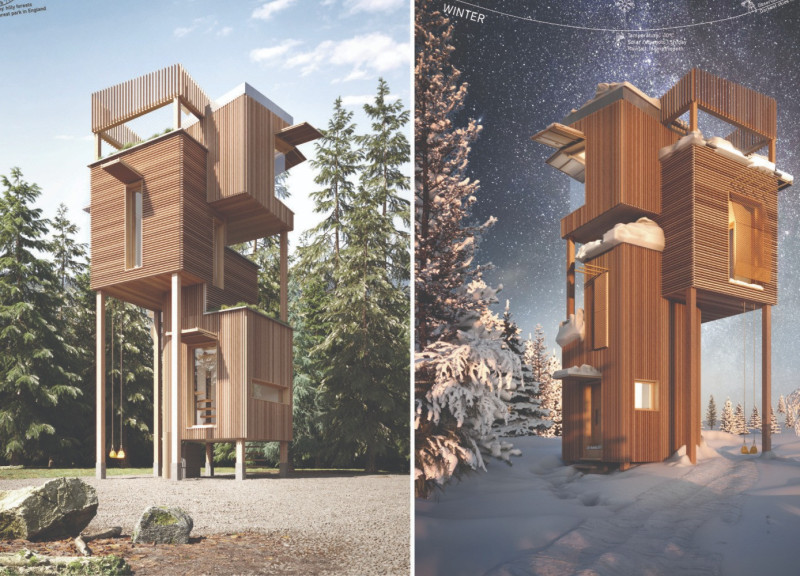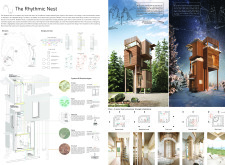5 key facts about this project
"The Rhythmic Nest" is an architectural design project that embodies an innovative approach to seasonal living. This project is conceptualized as an adaptive tiny house, specifically aimed at enhancing the living experience of couples in areas characterized by significant seasonal variations. The design integrates functional living spaces that change in response to the environmental conditions over the year.
The house serves multiple functions, including residential living, relaxation, and observation. Each space within the structure is meticulously designed to offer comfort, while also promoting a connection with nature. The architectural framework supports flexibility and adaptability, allowing the inhabitants to modify use and layout according to seasonal needs and preferences.
Adaptive Living and Sustainability At the heart of "The Rhythmic Nest" lies its unique ability to adapt to changing environmental conditions. The design prioritizes sustainable practices, focusing on materials and technologies that contribute to the project's ecological efficiency. The structure is elevated, which provides panoramic views of the surrounding landscape and minimizes disruption to the terrain. This elevation contributes to comfort, security, and an immersive experience in nature.
The project also incorporates advanced energy systems, including solar panels, that ensure self-sufficiency. Rainwater collection and recycling systems are pivotal to its water management strategy, effectively reducing the ecological footprint. Interior spaces are equipped with eco-friendly materials, such as low-VOC paints, which prioritize indoor air quality while supporting sustainability.
Design Elements and Functionality The interior layout of "The Rhythmic Nest" is characterized by multi-leveled spaces that offer distinct zones for different activities. Ground, mezzanine, first, second, and roof levels are designed to facilitate seasonal habitation. During winter months, areas may be configured for cozy, intimate gatherings, while in the summer, they can transition seamlessly into open, airy environments for relaxation and social interaction.
Material choices are integral to the architecture. The predominant use of wood, including materials such as cedar and oak, complements the natural ambiance, while glass elements enhance the visual connection with the external environment. Steel components provide essential structural support, balancing function with durability.
Exploring Architectural Ideas The innovative design approaches seen in "The Rhythmic Nest" underscore a contemporary understanding of seasonal rhythms in architecture. The project reflects important architectural ideas such as sustainability, adaptability, and spatial efficiency, serving as a potential model for future housing solutions.
For a deeper understanding of the architectural plans and design strategies employed, readers are encouraged to explore the full presentation of "The Rhythmic Nest." Detailed architectural sections and elements provide further insight into how this project compares to traditional approaches, illustrating a refined balance of functionality and aesthetic harmony within its ecological context.























